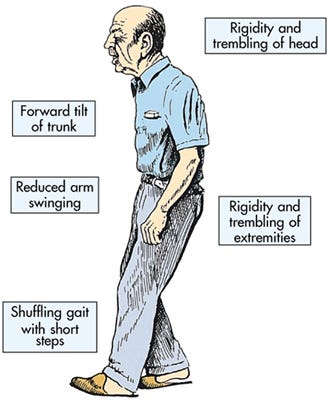Parkinson’s Disease is a neurological disorder, and named after physician Dr. James Parkinson who published a detailed description of the condition in 1817. Direct reference to conditions describing Parkinson’s disease is not available in classical Ayurveda texts. Ayurveda texts refer to different types of tremors. Parkinson’s disease is most commonly called Kampavata by current Ayurveda practitioners.
The most common recognisable symptom of Parkinson’s disease is known as a “pill rolling tremor.” In this condition, the thumb and fingers move uncontrollably in a manner resembling the rolling of a pill between the fingers. Tremors most commonly appear in the hands, arms, and legs, though other areas may be affected. Small movements of the hands and fingers may eventually be difficult. Another symptom is stambha (rigidity), in which movement becomes slow and difficult to initiate. Patients usually have to look at their feet to begin, shuffle forward and occasionally break into a trot (festination). The arms do not swing in coordination with the usual stride. The face may appear without expression (mask face), dull, or depressed; though no depression may be present. Reduced blinking is an early symptom. The voice becomes monotone and expressionless, further causing some to mistake this as depression.
Western medicine has determined the cause of Parkinson’s disease to be a loss of function of specialised cells in the brain stem which stimulate the production of the neurotransmitter, dopamine. Drugs supplying the brain with L-DOPA (a pre-cursor to dopamine) have been the mainstay of allopathic treatments of Parkinson’s disease. Ayurveda considers Kampavata as the manifestation of aggravated Vata, when Vata accumulates in brain tissues, damaging portions of the brain stem and causing altered coordination and tremors.
Dr Beckie Port writes about treating Parkinson’s disease through natural sources of L-Dopa. She mentions the risks of taking chemically synthesised L-Dopa
Levodopa is very effective, particularly in the early stages of the condition. But as Parkinson’s progresses and more brain cells are lost, more drug will need to be taken to get the same effects. And as the dose is increased to manage the symptoms of Parkinson’s the side effects themselves become unmanageable.(emphasis is mine)
Ayurveda uses Mucuna Pruriens which is a natural source of L-Dopa. L-Dopa whether natural or synthetic, is a replacement for the dopamine that the brain is no longer making. It does nothing to reverse or prevent further damage to the brain stem. Ayurvedic treatment of Parkinson’s disease is about the Vata disturbance. Ayurveda teaches that a holistic treatment regimen offers the greatest chance of success with Parkinson’s patients. In addition to using Mucuna pruriens, vata must be pacified.
Ayurvedic regimens have a lot to offer patients with Parkinson’s or other diseases. LiveRight is a startup offering solutions based on classical Ayurveda texts for the treatment of Parkison’s and other chronic ailments such as diabetes, arthritis, hypertension, migraine etc. Fix an appointment with one of our doctors today to regain your health and wellness.


